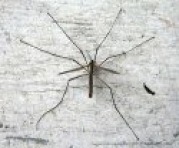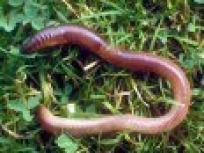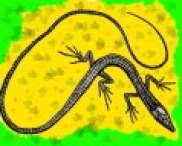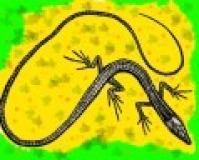Loading
Being some personal musings on catching wild insects as supplemental diet items for my insectivorous lizards.
Disclaimers, warnings and general comments
I will be the first to admit that catching wild food for your insectivorous lizard isn’t for everyone, but the variety and overall good nutrition found in wild-caught food can’t be beat. There are, of course, two opposing schools of thought on the use of wild-caught insects as part of your reptile or amphibian’s diet. I guess it’s pretty obvious what side of the fence I’m on! I suggest that you research a bit on the two views on the web before deciding to proceed. Wild-caught insects can be a great supplement to the regular diet, adding variety and nutrients not found in regular feeders. It is difficult, however, to feed a diet completely comprised of WCI (Wild-caught Insects), especially if you have several herps to care for. Also, obviously, it isn’t a winter-time pursuit. I was almost forced into it when my Asian long-tailed grass lizards (Takydromus sexlineatus) laid viable eggs. Suddenly I was faced with the prospect of feeding an extremely minute hatchling and no fruit flies or pinhead crickets to be found in my area except by order, which would take a week! Many helpful people on two forums, The Vivarium Forum (http://www.vivariumforum.com/) and the Turtle Forum (http://www.turtleforum.com/) got me through the first few days by encouraging me to look for my own food outdoors. Two people in particular were extremely helpful (you know who you are!). From there, I did a lot of research on the ‘net, and my findings can be seen in the “LINKS” section below. It’s a whole new world, and my lizards love it!
Remember - the final decision is entirely yours. I am just sharing my own experiences.
Please read those LINKS!!! They contain a lot of important and interesting info.
The only insects I am including here are those that I have personally fed to my Asian long-tails and on which they have put their stamp of approval. Some they have liked more than others, which I will indicate in the comments below. This is to say that other species of lizard may or may not like these insects, though it is likely that if they will eat crickets, they will eat these WCI with relish. I will add to this as we try new delicacies (I’m using the “we” very, very loosely).
All of these insects were collected in the Great Lakes region (I live in Southern Ontario, actually further south than Michigan)
The only insects I am including here are those that I have personally fed to my Asian long-tails and on which they have put their stamp of approval. Some they have liked more than others, which I will indicate in the comments below. This is to say that other species of lizard may or may not like these insects, though it is likely that if they will eat crickets, they will eat these WCI with relish. I will add to this as we try new delicacies (I’m using the “we” very, very loosely).
All of these insects were collected in the Great Lakes region (I live in Southern Ontario, actually further south than Michigan)
All right, now for a few wise words:
ALWAYS err on the side of caution. If you can’t identify it, don’t feed it. Double and triple check your ID. Then check it a fourth time just to be sure (this is the “belt and suspenders” philosophy of Life which I live by, especially when it comes to my family and pets.) There is a really good bug identification website in the LINKS below.
NEVER collect insects from areas where pesticides or herbicides have been used. If you’re not sure, don’t do it (see "belt and suspenders" above). Also, don’t collect from roadsides as harmful exhaust collects on plants and insects there. My acre of property has been completely organic for almost 20 years; my neighbour's for about 10, so I feel okay gathering here.
DON’T feed insects that have been eating plants with milky saps as these are generally toxic and apparently build up to high concentrations in the insect’s body.
BRIGHTLY COLOURED butterflies are a no-no. Brightly coloured any insect, really. It’s kind of Nature’s way of telling you it’s likely poisonous. The exception might be some types of leafhoppers.
BEES, WASPS, SPIDERS and ANTS are no-nos in my book. Should go without saying, right? Right??? Also, of course, things like scorpions if you happen to live where they abide. Anything that can hurt you can obviously hurt a lizard. Ants don’t hurt me, you say? Some types of ants will swarm, kill and completely devour a small lizard in an enclosed area before you can blink. Okay, so I exaggerate somewhat and I know there are some specific lizard species that ONLY eat ants, but let’s be logical, shall we? Same with spiders. I know that they comprise a large percentage of some wild lizards' diet, but I am so not going there.
Some collection tips and techniques
I have indicated in the species notes below where it is best to look for that particular insect. There are some bits of equipment that you may want to have; easy things to get a hold of. Firstly, remember that The Dollar Store Is Your Friend (you teachers out there already know this). Get a butterfly net and some of those little “bug collector” containers (they look like teeny-tiny Kritter Keepers). These you will find in the toy section. You can also use margarine or yogurt containers with a circular hole cut in the lid covered by glued-on fabric screening or mesh. Tall canning jars work really well because you can take out the solid middle part of the two-piece lid and replace it with a cutout piece of the fabric screening. That’s about it. WCI don’t really last long in captivity, I’ve found, so you’ll have to hunt daily or every other day. It actually gets fun as you learn to recognize the different bugs and their habitats (your idea of "fun" may vary).
One of the best places to look for flying insects such as moths, plume moths, crane flies, etc., is if you have a screen room or screen gazebo in your back yard. The wind blows through this and makes it into a giant capture net. Check out the walls of the gazebo every morning and evening. You’ll be surprised by what you find! (Note: this is the only place I’ve ever found plume moths, one of my hatchling’s very favourite foods). It also doesn't hurt that I have a solar garden light right near the screen. I'm sure this must attract a fair number of moths at night.Flying insets such as moths, etc., are best hand-fed to your critters. My lizards were extremely jumpy and would flee all over the tank whenever my hand went in there…until I started offering interesting tidbits held in plastic tweezers, that is! These tweezers came in a first-aid kit and are fairly long. They’re also soft so the lizzies don’t hurt themselves when they grab the bug. Best to try to grab the moth or whatever by the wings with the tweezers.
Sweeping with the net can be quite effective. Sweep across the leaves and branches of bushes and trees and check quickly what you have found (before they can get away from you!). Sort through for the good stuff. Watch out for bees and wasps!
Beating the bushes is also very effective for dislodging resting insects, particularly moths. The technique is exactly what it implies. Use your net to tap the branches of tall plants, shrubs and trees
Check your car first thing in the morning, especially if you park near or under trees. I know this sounds weird, but you'd be amazed what you find on the hoods and roof.
Catching crickets is a technique unto itself. I have to say that all of the designs I have seen for "cricket traps" have only resulted in me catching a nice crop of ants. Here's what I have discovered works. Crickets have an interesting sense of knowing when you are after them, so you have maybe one or two hops on their part before they burrow down into the roots of the grass and you can forget about capturing them down there. Have a small "critter keeper" and a tall plastic container (like a tall yoghurt container or the like). Once you see a cricket hopping, don't even think about trying to catch the individual cricket. Instead, grab for the handful of grass around and including the cricket and immediately dump this into the tall container. Carefully pull out the grass and plant matter and you should have a pretty jumpy cricket left in the container which you can then dump into the "critter keeper". Continue until you have as many as you need. Be aware that wild crickets are a bit more agile than domestic ones when you go to feed them to your herp. They also don't last as long in captivity.
One of the best places to look for flying insects such as moths, plume moths, crane flies, etc., is if you have a screen room or screen gazebo in your back yard. The wind blows through this and makes it into a giant capture net. Check out the walls of the gazebo every morning and evening. You’ll be surprised by what you find! (Note: this is the only place I’ve ever found plume moths, one of my hatchling’s very favourite foods). It also doesn't hurt that I have a solar garden light right near the screen. I'm sure this must attract a fair number of moths at night.Flying insets such as moths, etc., are best hand-fed to your critters. My lizards were extremely jumpy and would flee all over the tank whenever my hand went in there…until I started offering interesting tidbits held in plastic tweezers, that is! These tweezers came in a first-aid kit and are fairly long. They’re also soft so the lizzies don’t hurt themselves when they grab the bug. Best to try to grab the moth or whatever by the wings with the tweezers.
Sweeping with the net can be quite effective. Sweep across the leaves and branches of bushes and trees and check quickly what you have found (before they can get away from you!). Sort through for the good stuff. Watch out for bees and wasps!
Beating the bushes is also very effective for dislodging resting insects, particularly moths. The technique is exactly what it implies. Use your net to tap the branches of tall plants, shrubs and trees
Check your car first thing in the morning, especially if you park near or under trees. I know this sounds weird, but you'd be amazed what you find on the hoods and roof.
Catching crickets is a technique unto itself. I have to say that all of the designs I have seen for "cricket traps" have only resulted in me catching a nice crop of ants. Here's what I have discovered works. Crickets have an interesting sense of knowing when you are after them, so you have maybe one or two hops on their part before they burrow down into the roots of the grass and you can forget about capturing them down there. Have a small "critter keeper" and a tall plastic container (like a tall yoghurt container or the like). Once you see a cricket hopping, don't even think about trying to catch the individual cricket. Instead, grab for the handful of grass around and including the cricket and immediately dump this into the tall container. Carefully pull out the grass and plant matter and you should have a pretty jumpy cricket left in the container which you can then dump into the "critter keeper". Continue until you have as many as you need. Be aware that wild crickets are a bit more agile than domestic ones when you go to feed them to your herp. They also don't last as long in captivity.
Okay – on to the individual insects I have successfully fed to my lizards; where to find them and how to capture and serve them (always on your best china and crystal, of course. Your mother would be proud). ...and don't forget to read the links!
***The pictures used in the following were taken from images on the 'net. I have striven to only include royalty-free photographs or those in the public domain. If you find out otherwise, please let me know!***
***The pictures used in the following were taken from images on the 'net. I have striven to only include royalty-free photographs or those in the public domain. If you find out otherwise, please let me know!***
LEAFHOPPERS
These are pretty interesting insects and masters of deception as they mimic leaves a lot of the time. I find them on the slender branches and twigs of smaller trees in my yard; seldom actually on leaves. They do have wings which they employ when they spring away, but they are fairly easy to catch with your bare hands. The ones I find here range from the very small (1/8") to a moderate size (1/2" to 3/4"). There are a lot of species of leafhoppers, including some very brightly coloured and striped varieties. The ones I usually find are usually green, white or brown, however. The adult lizards love these. The hatchling will sometimes take one if they are the right size.
TREE CRICKETS
You will likely hear these rather than see them. I lucked into a couple by a fluke when "sweeping" with my net. They met with much excitement when presented to my hatchling. Kind of like a "candy" version of a cricket, I guess.
PLUME MOTHS
I was completely unaware of the existence of these moths until I found some clinging to my screen room this year. Their wings in flight resemble feathers (hence the name). At rest, the wings are rolled up into a tube. One of my hatchling's favourite menu items. They are small, about an inch of wingspan, if that.
VARIOUS SMALL MOTHS
Generally neutral colours (beiges, browns, etc.), moths will usually rest with their wings open (as in the picture). There are lots of species of moth (I think I read that there are more species of moth than of butterfly!). They are mostly nocturnal, so you probably won't see them just flying by during the day, but you will find them at rest and will likely disturb them when sweeping or beating the bushes. Make sure they're not too big for your lizard.
FIELD CRICKET (BLACK CRICKET)
Kind of like wild blueberries, I guess, they are frequently (but not always) smaller than domestic crickets....or maybe it's just that I happen to find them at a certain point in their life cycle. Anyhoo, tricky to catch.
SEED MOTH (ALSO KNOWN AS THE FLOUR OR PANTRY MOTH)
You know this scenario - you open up that bag of flour that's been sitting in the cupboard and out fly a couple of tiny moths. Then you realize the flour itself is full of worms (that's their larvae). Yuck! I'm not suggesting that you should encourage these moths to infest your house because they're really hard to eradicate, but if you happen to come across a couple in your travels through your pantry, your lizards will thank you. They love 'em...so do turtles. I also keep birds, and these moths often come in hidden in bird seed. Bonus!
MAYFLIES (FISHFLIES, JUNEFLIES, ETC)
These things have a different name in every region of North America, so it seems, but you'll know what I'm talking about when you see the picture. It's really unfortunate that they only swarm once or twice a year because the long-tails really love them. We didn't get many here this year, so I asked for a ziplock bag when visiting some friends a few weeks ago and started picking them off the wall (the flies, not the friends). Be sure to only do this with really good friends or people you never want to see again.
CRANE FLY
What looks like a giant mosquito but isn't a mosquito? Yes, the crane fly! (Use that in your next Trivia Game). You may not think a little lizard like a long-tail could get one of these down, but they can! Face it - the body of the crane fly isn't very big, and the legs must just follow the body down the hatch. Not for hatchlings, though.
EARWIGS
Eewwwwww! Now everyone together - ewwwwwwwww! Okay, now that we have that out of our systems, let's talk about earwigs. Those hideous "pincer" things aren't pincers and are totally harmless. They also can't get in your ear and drive you insane, so you can't use that as an excuse. They are easy to find (under things like your garbage can or pieces of wood or just about anything). They like damp places. I'm like you - if you had told me a year ago that I'd be looking for earwigs and picking them up in my bare hands I'd have laughed in your face. I guess the lizards are laughing now.
SOWBUG (PILLBUG, ETC)
Like miniature tanks, these are actually cructaceans! They're small and can be found in the same places as earwigs, as well as in soil. Although edible, I haven't actually seen a lizard eat one (I've read that they have a pretty crusty exterior), but they are excellent as sanitary engineers in a fully-planted tank, aided by the earthworms. These are good guys!
APHIDS
Great for hatchlings...they're really, really small. Often found on the growing tips of rose bushes. If you try to collect them by hand, you'll only squish them, so you can either shake the branch over a container or trim the entire tip of the branch with all of the aphids and put this in the tank. Make sure there are no thorns and that the roses haven't been sprayed.
EARTHWORMS
Most lizards won't actually eat mucousy things like earthworms, but these little guys are your planted tank's best friend. You'll never see them at work behind the scenes, but they're there, working night and day to keep your soil healthy and processing poop and other good things.
THE BAD
**For some reason, the insects that are not good for your lizard are the most prolific - figures, huh? I guess if critters liked to eat them, there wouldn't be so many of them.
There are more insects that are inappropriate for your herp, so check the guides in the links. Here are a few:
There are more insects that are inappropriate for your herp, so check the guides in the links. Here are a few:
FIRE FLIES
Very, very toxic. Big no-no.
These have been known to kill bearded dragons within 24 hours.
Very, very toxic. Big no-no.
These have been known to kill bearded dragons within 24 hours.
Box Elder Beetles (aka Maple Bugs)
They're everywhere, they're everywhere! But they aren't edible.
They're everywhere, they're everywhere! But they aren't edible.
Japanese beetles
Mixed reports on these widespread pests, including some very disturbing ones. Bottom line - don't do it.
Bees or Wasps
Ants
Mosquitos
Spiders
You don't really need pics now, do you? Or reasons not to offer these to your lizard?
Mixed reports on these widespread pests, including some very disturbing ones. Bottom line - don't do it.
Bees or Wasps
Ants
Mosquitos
Spiders
You don't really need pics now, do you? Or reasons not to offer these to your lizard?
...AND THE UGLY
(bugs that are edible, but that I don’t use for various reasons)
(bugs that are edible, but that I don’t use for various reasons)
GRASSHOPPERS
Grasshoppers are actually supposed to be edible to lizards, but don't put them in your planted tank unless you want it to look like a plague of locusts descended upon it - which is exactly what happened. I only put one small one in and ended up with some very large holes in some of the leaves of my plants before the lizards were finally able to catch it....grasshoppers are very agile.
LINKS
This is the one that got me started. Lots of great information: http://www.repticzone.com/forums/Anoles/messages/1932711.html
The following six links comprises a wonderful series of articles by Frank Indiviglio on “That Pet Place”. Be sure to also read the comments and observations by readers.
http://blogs.thatpetplace.com/thatreptileblog/2008/10/06/terrestrial-isopods-sowbugs-pillbugs-potato-bugs-as-food-for-captive-reptiles-and-amphibians/
http://blogs.thatpetplace.com/thatreptileblog/2009/04/06/leaf-litter-invertebrates-as-food-for-small-insectivorous-amphibians-and-reptiles/
http://blogs.thatpetplace.com/thatreptileblog/2009/07/24/collecting-live-food-for-amphibians-and-reptiles-pitfall-traps/
http://blogs.thatpetplace.com/thatreptileblog/2009/08/03/pitfall-traps-part-2-caterpillar-hunter-beetles-in-the-terrarium/
http://blogs.thatpetplace.com/thatreptileblog/2009/05/11/collecting-live-food-for-reptiles-and-amphibians-an-entomologist%e2%80%99s-technique/
http://blogs.thatpetplace.com/thatreptileblog/2008/07/24/building-a-termite-trap-%e2%80%93-gathering-termites-as-food-for-poison-frogs-and-other-small-amphibians-and-reptiles/
It is important to ID potential food. This helps:
http://www.insectidentification.org/
The following six links comprises a wonderful series of articles by Frank Indiviglio on “That Pet Place”. Be sure to also read the comments and observations by readers.
http://blogs.thatpetplace.com/thatreptileblog/2008/10/06/terrestrial-isopods-sowbugs-pillbugs-potato-bugs-as-food-for-captive-reptiles-and-amphibians/
http://blogs.thatpetplace.com/thatreptileblog/2009/04/06/leaf-litter-invertebrates-as-food-for-small-insectivorous-amphibians-and-reptiles/
http://blogs.thatpetplace.com/thatreptileblog/2009/07/24/collecting-live-food-for-amphibians-and-reptiles-pitfall-traps/
http://blogs.thatpetplace.com/thatreptileblog/2009/08/03/pitfall-traps-part-2-caterpillar-hunter-beetles-in-the-terrarium/
http://blogs.thatpetplace.com/thatreptileblog/2009/05/11/collecting-live-food-for-reptiles-and-amphibians-an-entomologist%e2%80%99s-technique/
http://blogs.thatpetplace.com/thatreptileblog/2008/07/24/building-a-termite-trap-%e2%80%93-gathering-termites-as-food-for-poison-frogs-and-other-small-amphibians-and-reptiles/
It is important to ID potential food. This helps:
http://www.insectidentification.org/

























